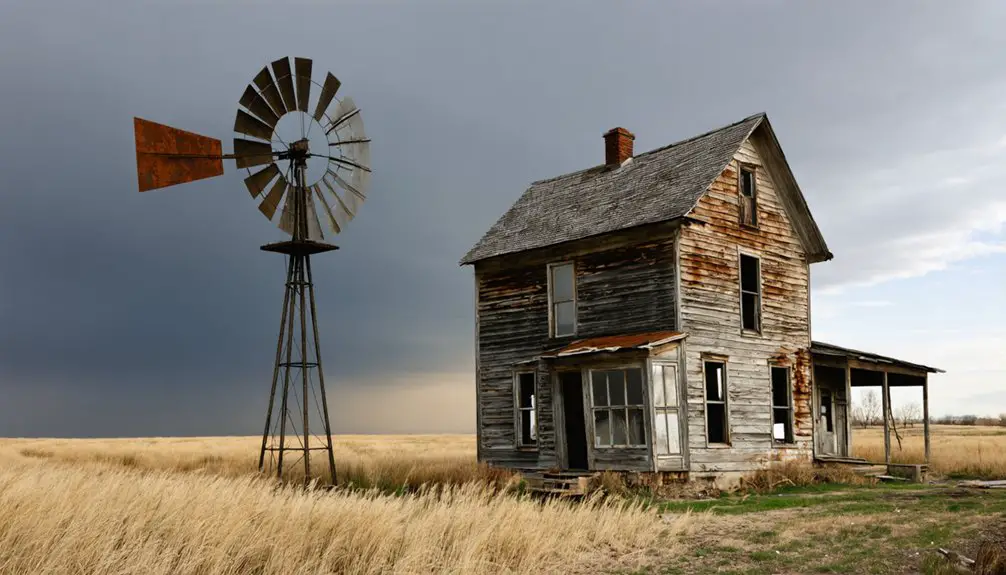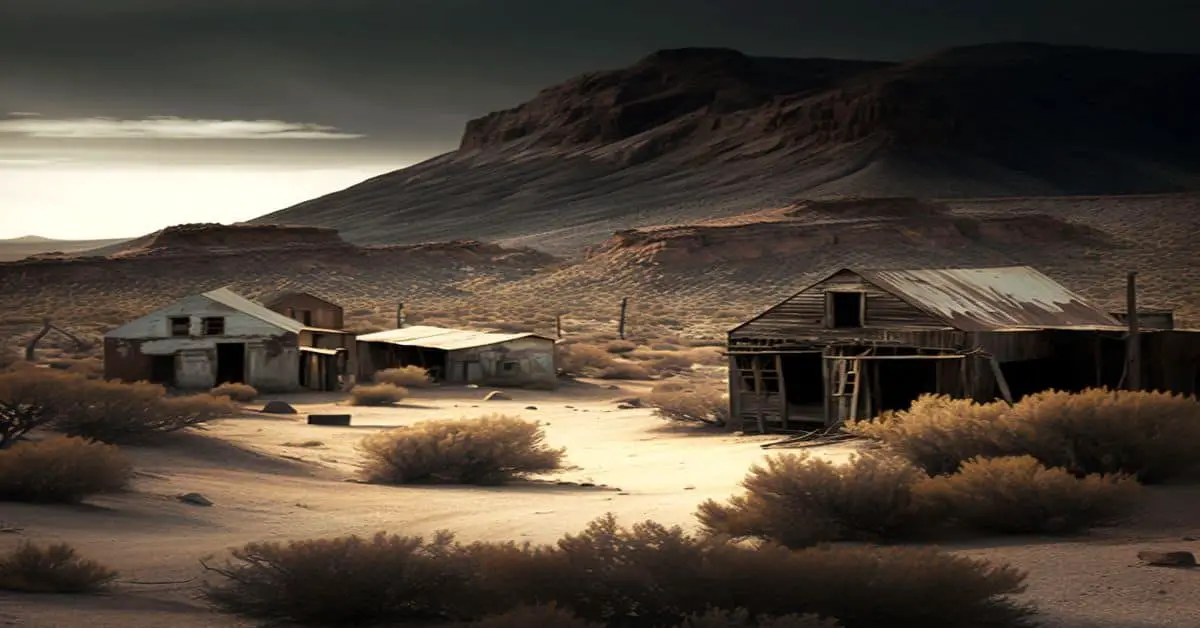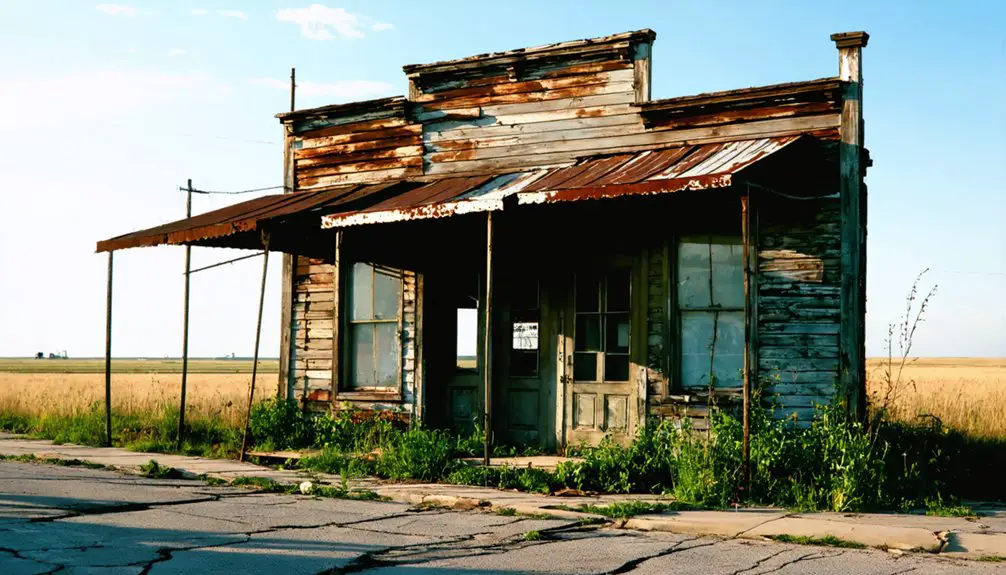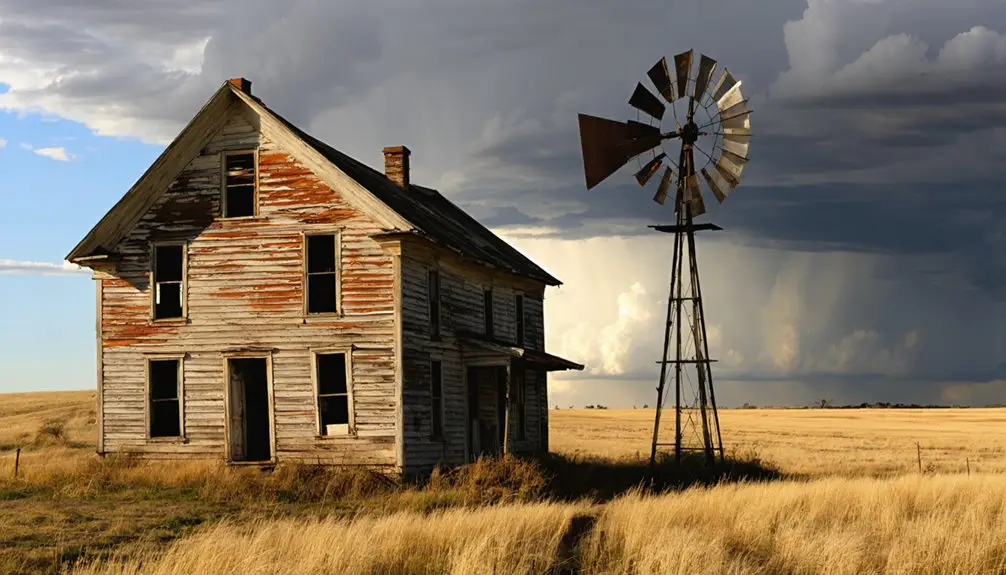You’ll find Andrews, Nebraska’s ghost town remnants from its early 1900s establishment, when it flourished with essential businesses like a blacksmith shop, grocery store, and post office. The town’s decline began in 1904 when a competing railroad grain elevator decimated local trade, leading to the post office’s closure by 1951. Today, abandoned structures and weathered ruins tell stories of frontier life, while giant oaks and elms reclaim the original street layout, preserving countless untold tales.
Key Takeaways
- Founded in the early 1900s, Andrews was a small Nebraska settlement with essential businesses serving about 25 residents by 1906.
- A competing railroad grain elevator built in 1904 destroyed Andrews’ loading facilities, triggering the town’s irreversible economic decline.
- The town featured Morrison’s grocery, Watson’s barbershop, and School District #30, which served as community gathering spaces.
- Andrews’ post office closure in 1951 marked a significant milestone in the town’s abandonment.
- Today, abandoned structures and original street layouts remain visible among meadowlands, exemplifying Nebraska’s frontier-era ghost towns.
The Rise and Fall of a Prairie Settlement
Although Andrews, Nebraska began with promising prospects in the early 1900s, the small prairie settlement’s fate would mirror countless other railroad-dependent towns of its era.
The development reflected a larger pattern of westward expansion, as an estimated 500,000 travelers migrated between 1841 and 1866.
You’ll find its origins on land leased by Pavel and Marach, where community dynamics quickly took shape with essential establishments like a blacksmith shop, grocery store, post office, and dance hall. By 1906, you could count about 25 residents calling Andrews home.
Like many settlements of the time, Andrews emerged to serve as a vital hub where early settlers could collect their mail and maintain social connections.
The town’s agricultural decline began when the railroad company built a competing grain elevator nearby in 1904, then destroyed Andrews’ loading facilities. This devastating blow crippled the local grain trade, and you can trace the town’s steady deterioration through its reduced parcel lots by 1918.
A single corporate action in 1904 sealed Andrews’ fate when the railroad destroyed its grain facilities, triggering the town’s irreversible decline.
The post office’s closure in 1951 marked the final chapter of Andrews’ brief existence.
Life in Early Andrews: Community and Commerce
While the railroad brought Andrews into existence, it was the vibrant community life that gave the settlement its heart and soul. You’d find economic sustainability through diverse businesses like Morrison’s grocery and post office, Watson’s mixed-use barbershop, and essential railroad facilities. The Fremont & Elkhorn depot established the town’s foundation in 1885.
The town’s community engagement thrived at School District #30, where education merged with church services and social gatherings. Like Brownville’s historic legacy, Andrews was home to cultured pioneers who helped shape Nebraska’s early development.
Whether you wanted entertainment or connection, Andrews delivered. You could join the local baseball team, attend Saturday night dances at the hall, or enjoy seasonal activities like ice skating and sleighing.
The schoolhouse, picnic grounds, and café served as social hubs where railroad workers mingled with farmers and shopkeepers, creating a tight-knit prairie community that balanced work with pleasure.
Surviving Structures and Historical Legacy
Despite decades of abandonment, Andrews’ architectural legacy persists through scattered homesteads and farmhouses that dot the landscape.
You’ll find these abandoned structures in various states of decay, with broken windows and collapsed roofs telling stories of past lives. Through openings, you can glimpse remnants of domestic life: broken furniture, scattered dishes, and old technology. Like many ghost town sites, some structures have completely disappeared while others remain standing in various states of preservation.
The town’s abandoned architecture extends beyond homes to include commercial ruins like the Lone Tree saloon and unfinished stone foundations of planned civic buildings.
Many local residents believe the town’s decline paralleled other Nebraska communities when youth migration led to dwindling populations.
Natural reclamation has transformed the scene, with giant oaks and elms embracing the structures, while owls make their homes in deteriorating barns.
The original street layout remains visible, though now merged with meadowlands, creating a haunting reflection of Andrews’ unfulfilled ambitions and eventual decline.
The Role of Railways in Andrews’ Destiny
The iron rails of the Fremont, Elkhorn & Missouri railroad shaped Andrews’ destiny from its 1885 founding as a train depot on what locals called the “Cowboy Line.”
You’ll find the town’s origins deeply intertwined with its railway infrastructure, which included a water tower, coal chute, and two sidings to support railroad operations. During its peak, Andrews was served by the Chicago & Northwest Railroad, which later became a vital part of the region’s transportation network. Serious flooding in spring 1982 severely damaged sections of track, contributing to the area’s rail decline.
The railway’s influence created a vibrant community where you would’ve seen:
The railroad didn’t just lay tracks – it laid the foundation for a thriving town filled with working families and local commerce.
- Railroad worker housing and businesses like cafés and stockyards springing up to serve rail employees
- A bustling post office and social gatherings centered around train schedules
- Baseball teams named after prominent railroad families like the Hiltons and Watsons
The economic impact proved both blessing and curse – while the rails brought prosperity, their eventual abandonment in the 1980s sealed Andrews’ fate as a ghost town.
Nebraska Ghost Towns: Andrews in Context
Among Nebraska’s scattered ghost towns, Andrews stands as a compelling example of the state’s boom-and-bust settlement patterns during the frontier era.
You’ll find its story echoes through local folklore, mirroring the fate of similar communities like Oreopolis and Morseville, where promise gave way to decline. Like other abandoned settlements across America, it represents part of the estimated 3,800 ghost towns that have been documented and mapped nationwide.
Similar to how mail was redirected from Morseville to Holstein in 1889, the town’s economic changes followed a familiar pattern you’ve seen across Nebraska’s landscape. Initially thriving with its schoolhouse, post office, and various businesses, Andrews couldn’t escape the broader forces that emptied many frontier settlements.
By the 1980s, you’d have found only sparse remnants – an old dance hall and the Swartz frame house – where a bustling community once stood.
Like its ghost town counterparts, Andrews reveals how changing transportation patterns and economic shifts transformed Nebraska’s rural fabric.
Frequently Asked Questions
Are There Any Photographs or Maps of Andrews From Its Peak Period?
Like searching for a needle in a haystack, you won’t find historical photographs from Andrews’ peak. While vintage maps might exist in county archives, they’re not readily accessible.
What Happened to the Residents When Andrews Was Abandoned?
You’ll find residents scattered due to economic decline, following predictable migration patterns – relocating to nearby towns with better jobs, schools, and services after their community’s railroad and businesses shut down.
Were There Any Notable Crimes or Incidents in Andrews’ History?
In a town of less than 100 residents, you won’t find any documented crimes or unsolved mysteries. Historical anecdotes reveal only peaceful community gatherings, social events, and typical railroad town activities.
Did Any Famous People Ever Live in or Visit Andrews?
You won’t find any documented famous visitors or residents in the records. The town’s limited historical significance and short lifespan from 1906 to 1951 didn’t attract notable personalities.
Are There Any Annual Events or Gatherings Held at the Ghost Town?
You won’t find any ghost town festivals or community gatherings held there today. The site’s remote location and lack of remaining structures make it impossible to host organized events.
References
- https://sioux.wnfrhc.org/towns/andrews/
- https://history.nebraska.gov/wp-content/uploads/2017/12/doc_publications_NH1937GhostTowns.pdf
- https://www.youtube.com/watch?v=redtU6GT-BY
- https://www.onlyinyourstate.com/trip-ideas/nebraska/ne-ghost-towns-road-trip
- https://nebraskarules.tripod.com/id6.html
- https://www.youtube.com/watch?v=RODvVi84tLk
- https://durhammuseum.org/1878-map-of-douglas-sarpy-counties-neb/
- https://en.wikipedia.org/wiki/Andrews
- https://history.nebraska.gov/wp-content/uploads/2017/12/doc_publications_NH1943Communities.pdf
- https://www.americanheritage.com/ghost-town-river



